Mushrooms have long been treasured by culinary experts and amateur cooks alike. Cluster mushrooms are a species of fungi that grow in clusters and can be found in many shapes and sizes.
These mushrooms are known for their unique taste and ability to add flavor to dishes. Cluster mushrooms have a long history of use in cooking and as a natural dye. In recent years, they have become increasingly popular with more people venturing outdoors to find these fungi. Below we’ll list the most common mushrooms that grow in clusters.
List of Mushrooms that grow in clusters
It is important to be cautious when identifying and consuming wild mushrooms, as some species can be poisonous. If you are unsure whether a mushroom is safe to eat, it is best to err on the side of caution and not consume it.
1. Maitake Mushroom (Hen of the Woods)
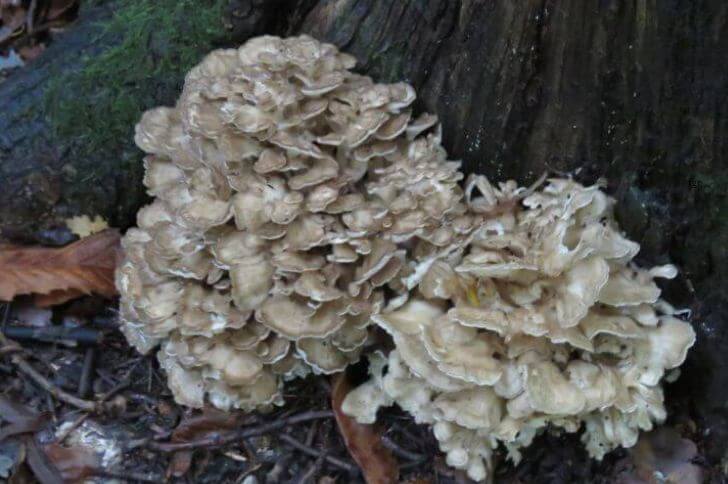
A mushroom of many names. Maitake or ram’s head or hen of the woods or sheep’s head is a type of brown cluster mushroom that occurs in North America as well as Europe.
Identification:
With their overlapping clusters of thick, spoon-shaped caps and earthy flavor, they are a favorite among foragers. Identifying a true Hen of the Woods can be tricky because there are other lookalikes. Fortunately, there are several characteristics to look for that will help you make the right call.
The first key identifier is the shape of its cap which is spoon-like or curly with wavy margins. The top surfaces of these caps have varying colors such as grayish brown to yellowish tan with darker hues around its edges. No gills.
If you’re looking to add maitake mushrooms to your diet, you can find them fresh or dried at most health food stores. You can also buy maitake supplements in capsule form.Or if you live close to a wooded area, you can forage for maitakes.
2. Oyster mushroom
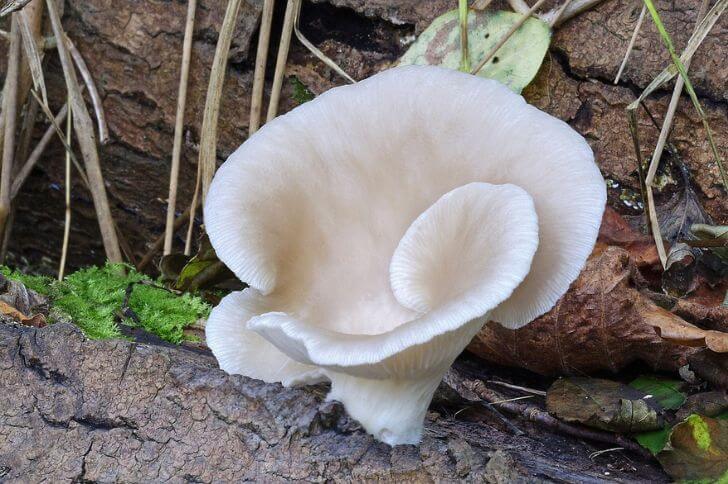
Oyster mushrooms are popular in many cuisines. The mushrooms typically grow in clusters on trees or logs.
Identification:
There are various varieties of oysters and they come in different shapes and colors depending on the region. The most common include:
King trumpet mushroom – These mushrooms have small thick caps and stalks. Unlike other oysters, they grow on roots instead of decaying wood.
Pearl oyster mushrooms – These white cluster mushrooms have fan shaped caps with creamy gills on their underside. Flesh is white.
Pink oyster mushrooms – They have similar physical appearance as the pearl oyster mushrooms. However caps are thinner and are pink.
Golden oyster mushrooms – Like other oysters they grow in clusters or bunches. Note their small golden or yellow caps with velvety texture. They have long curved stipes.
Oyster mushrooms have a mild, slightly sweet taste that makes them a versatile ingredient in many dishes. They can be sauteed, grilled, or used in soups or stews. Oyster mushrooms are a good source of protein, fiber, vitamins, and minerals.
3. Enoki Mushrooms
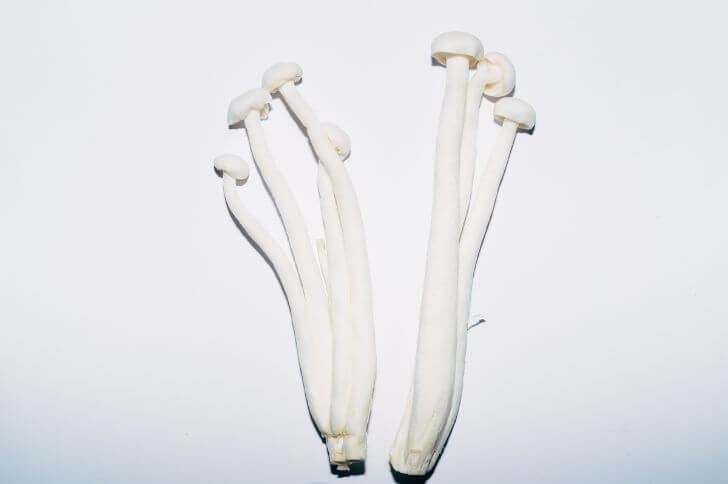
We recently discussed enoki mushrooms in this article. And because it fits this category perfectly, we’ve decided to include it here so if you didn’t get to read that article, you can learn more about these long cluster mushrooms here.
Identification:
Enoki Mushrooms are an edible variety of mushrooms that have a distinct shape and flavor. They are long, thin and white with a small cap at the top. These mushrooms are commonly used in Asian cuisine, particularly in Japan where they are known as Enokitake.
They can be found fresh or canned and can be easily identified by their slim texture and appearance. When cooking with Enoki Mushrooms, it is important to note that they do not need to be cooked for very long; just until they become tender.
This is due to their delicate nature which can cause them to become soggy if over-cooked. Additionally, they should always be added at the end of cooking so they don’t lose any of their flavor or texture.
4. Glistening Inkcap (Coprinellus Truncorum)
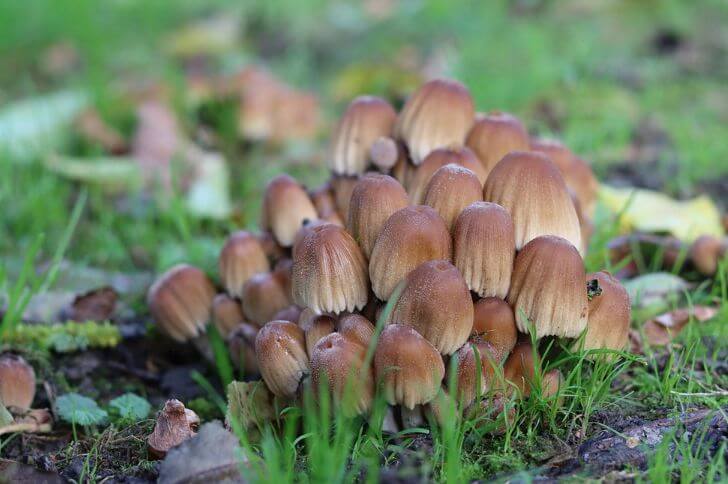
Coprinellus truncorum, also known as the glistening ink cap, is a species of fungus in the family Coprinaceae.
Identification:
The fruit bodies of the fungus are long brown with conical caps. Young mushrooms have whitish gills that turn black as the mushroom ages.
They grow in clusters on dead wood or roots, and are often found in urban environments. The spores of the fungus are black.
This species is edible when cooked, but not a favorite among foragers. Glistening inkcaps do not have a distinctive taste. They are common in all seasons except winter.
5. Hedgehog mushrooms
Hedgehog mushrooms or sweet tooth mushrooms are large fungi that are found in very tight clusters.
Identification:
These mushrooms have an interesting physical appearance that is easily recognizable to foragers and mushroom enthusiasts. Hedgehog mushrooms get their name from their spiny caps, which resemble the spines of a hedgehog.
These mushrooms can range in size from 4-6.5 inches across, and have brownish-red caps. Also their fruity (apricot) smell will help you identify it. their dense flesh which bruises brown when touched, as well as their spore print pattern of white or off-white.
Hedgehog mushrooms are often used in soups and stews, or dried and ground into a powder to be used as a seasoning. This species of mushroom grows in temperate woodlands, particularly near deciduous trees such as oaks and beeches.
6. Chicken of the Woods
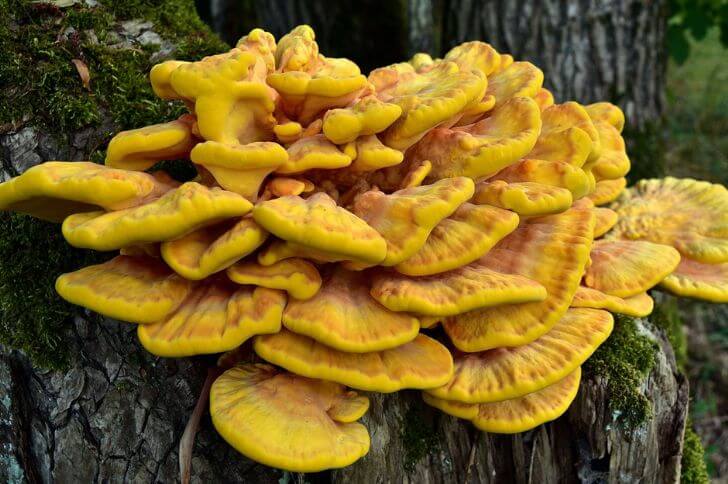
Often confused with maitake, chicken-of-the-woods or sulphur shelf or chicken fungus is a large orange mushroom that is mostly found growing on eucalyptus or conifer trees.
Identification:
Sulphur shelf mushrooms are a type of edible mushroom that can be found growing on decaying wood in many parts of the world.
These mushrooms have a yellow-orange color and one shelf ranges from 2-10 inches in length.
Identifying sulphur shelf mushrooms is an important step for amateur mushroom hunters looking to add these delicious fungi to their meals.
The most notable feature on chicken fungi is their orange/yellow bracket-like shape which is divided into several segments.
In addition, they have white pores on the undersides which contain the spores used for reproduction. Those hunting for this fungus should also check if the flesh is white or yellow-orange.
Chicken fungi is a great substitute for chicken.
7. Honey Fungus
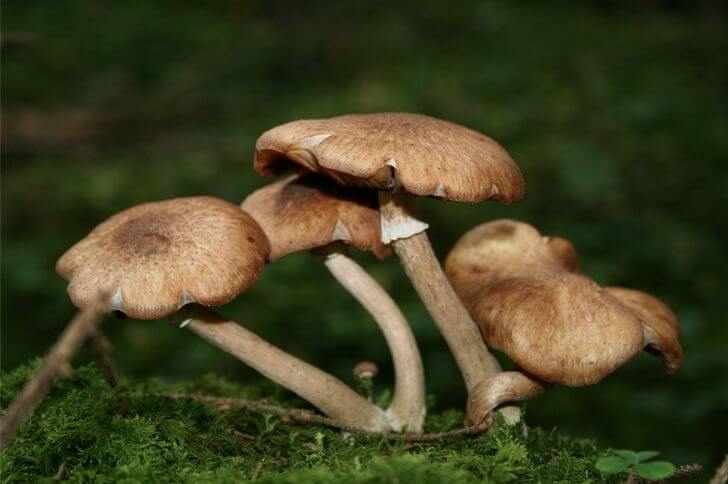
Honey fungus is a species of parasitic fungi that affects trees and woody plants. You may know honey mushroom cluster as pipinky, stumpie or stump mushroom.
Identification:
It can be identified by its distinctive yellow convex to flat caps, which are named after their sweet odor.
The yellow color deepens to an orange or rust shade as the fungus matures. Honey fungus is found throughout the northern hemisphere, but it’s most common in temperate climates like those found in Europe and North America.
These mushrooms can be found in many different types of environments, but they are most commonly found in wooded areas.
The honey fungus mushroom is considered to be a delicacy by many people, and it is often used in cooking.
8. Shimeji Mushroom
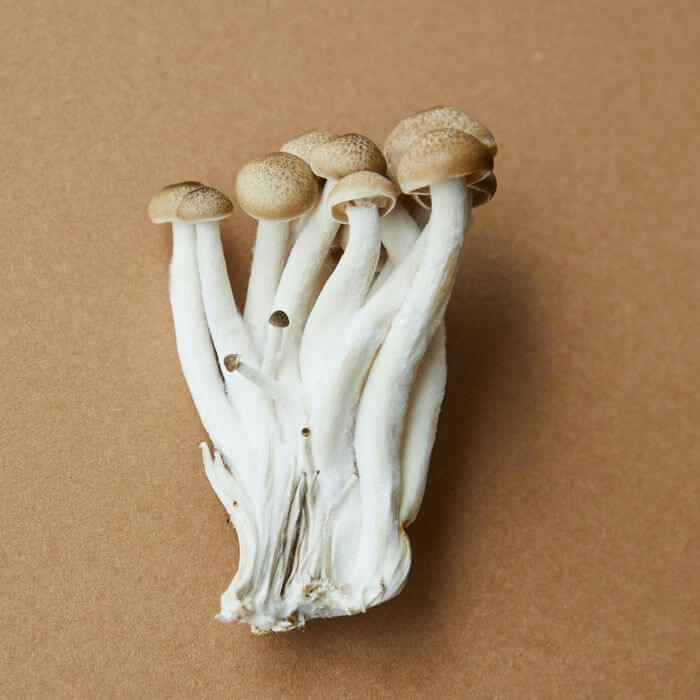
The Shimeji mushroom is a species of edible mushroom that is native to East Asia. There are 5 varieties of this delicious fungi.
Identification:
They have a unique, delicate flavor and texture that make them popular additions to many recipes. Identifying shimeji mushrooms is essential for anyone who wants to cook with these delicacies.
The most distinguishing feature of shimeji mushrooms is their cluster-like growth pattern; they tend to grow tightly packed together on wood or soil.
The color of the cap varies from light brown to dark brown and its shape can range from conical to flat. Additionally, these mushrooms often have white stipes or stems.
The Shimeji mushroom has a white cap with a brownish-red stem. Their white flesh is firm. The taste of the Shimeji mushroom is slightly nutty with a hint of sweetness.
The Shimeji mushroom is a popular ingredient in Asian cuisine, particularly in Chinese and Japanese dishes. It can be used in stir-fries, soups, and stews. The Shimeji mushroom is also often used as a filling for dumplings and wontons.
9. Wood Blewit Mushroom
Wood Blewit Mushroom, or scientifically called Lepista nuda, is an edible mushroom that occurs in North America and Europe.
Identification:
This mushroom has a distinct look when it comes to identifying it from other mushrooms in the wild. It has a large, fleshy cap that reaches up to 6 inches across, which is generally smooth and purple in color.
Its gills are densely packed together, lilac in color and they turn brown as they age. The stems are quite thick at the base and become thinner towards the top with a diameter of 2 inches.
The Wood Blewit can also be identified by its unique aroma; its scent often being compared to frozen oranges.
This mushroom can be found growing solitary or in groups on well-rotted wood chips, sawdust, or logs from deciduous trees.
10. Black Trumpet Mushrooms
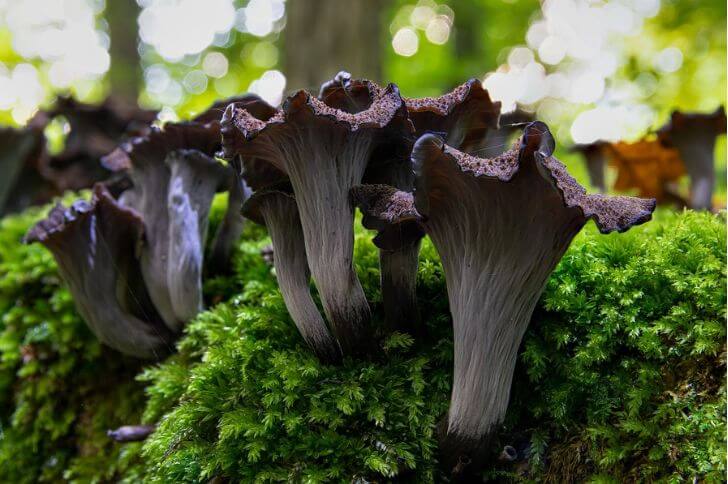
Black trumpet mushrooms are some of the most delicious black fungi of North America and Europe. Common names include black chanterelle in North America, djondjon in Haiti, , trombetta dei morti in Italian and trompette de la mort in French.
Identification:
This flavorful mushroom has a unique shape and color that makes it easily recognizable to experienced foragers. With its distinctive funnel-like shape, black trumpet mushrooms have an black exterior and light gray on the underside.
These mushrooms grow in clusters near tree roots or at the base of broadleaf trees such as oaks. They usually appear during wet weather but can also be found during dry periods.
Interestingly, black trumpet mushrooms are often used in culinary dishes because of their unique flavor.
They have been described as having an earthy taste; they remind me of apricots. Additionally, they are often used as an ingredient in soups and sauces.
If you’re looking to add something new to your cooking repertoire, consider trying black trumpet mushrooms. With their unique flavor and appearance, they’re sure to make any dish more interesting.
Related read: Check out mushrooms of the Southwest
11. White Chanterelles
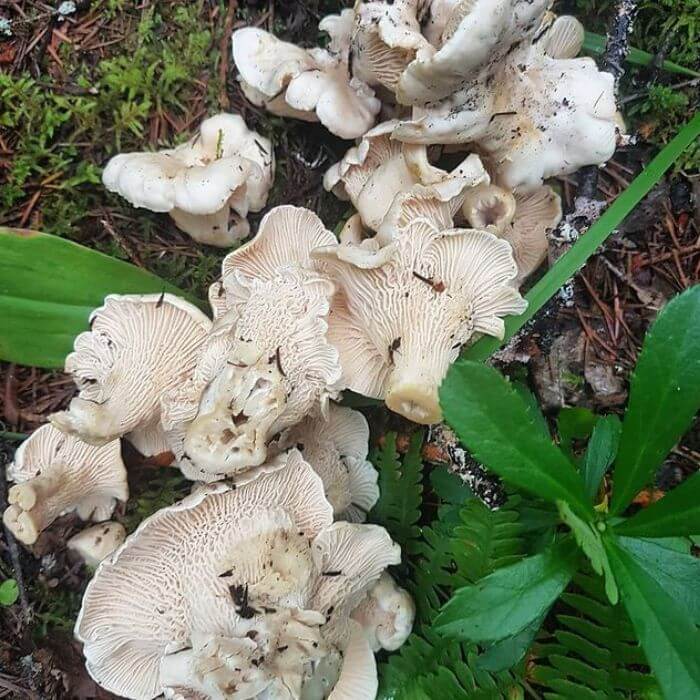
source: rockymountain_sporehouse
White chanterelles are delicious. Mostly found in the Pacific Northwest, this unique fungi is common in pine forests.
Identification:
White chanterelles have a white or cream-colored cap and a stem that is typically about the same color. The gills on the underside of the cap are also white.
These mushrooms are often used in cooking because of their delicate flavor. They can be sautéed or baked.
White chanterelles can also be used in soups, stews, and sauces. When hunting white chanterelles, look for mushrooms that have a fresh appearance and are free of blemishes.
12. Fried Chicken Mushrooms
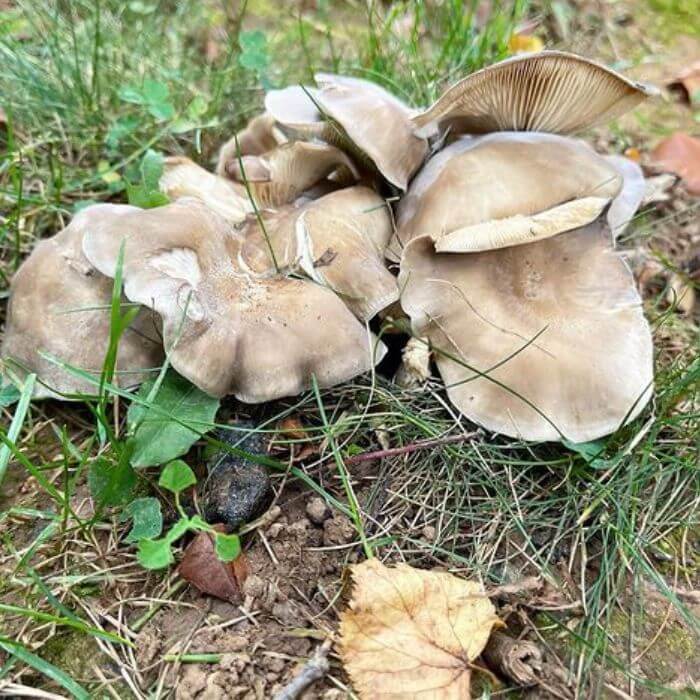
source: daydreamer_dreamweaver
Lyophyllum decastes, you may know it as chicken of the gravel or fried chicken mushroom, is an edible species of cluster mushroom found in temperate regions around the world.
Identification:
This mushroom is highly prized for its delicious flavor and meaty texture. Aside from its culinary value, the fried chicken mushroom has a unique appearance and can be easily identified by most foragers.
The cap is about 2-5 inches in diameter and often whitish-gray in color with white gills that turn yellowish as it ages. The stem of the mushroom can grow to 4 inches long and be as thick as 2 inches wide; it also typically has a whitish hue.
13. YellowFoot Mushrooms
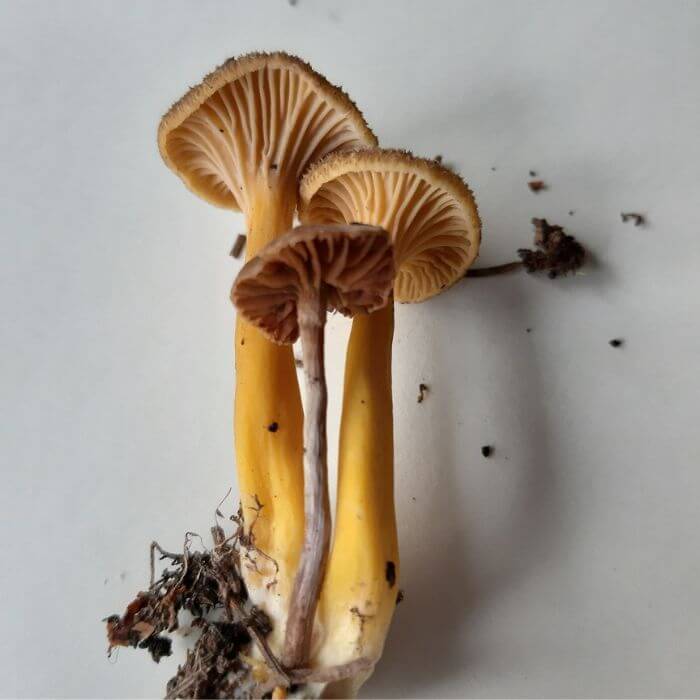
Another type of mushrooms that grow in clusters that you should know about are the yellowfoot mushrooms. A member of the chanterelle family, it has similar features to chanterelles.
Identification:
Known by many names, including the funnel chanterelle and winter mushroom, this species is most easily identified by its distinctive funnel-like cap shape.
The exterior of yellowfoot can vary slightly in hue from bright orange to pale yellow depending on where it was harvested.
The inside flesh of the mushroom is white with small pores while its gills are forked. Is this winter mushroom edible? Yes, yellowfoot is edible and is great for making omelets.
14. Pheasant’s Back Mushroom
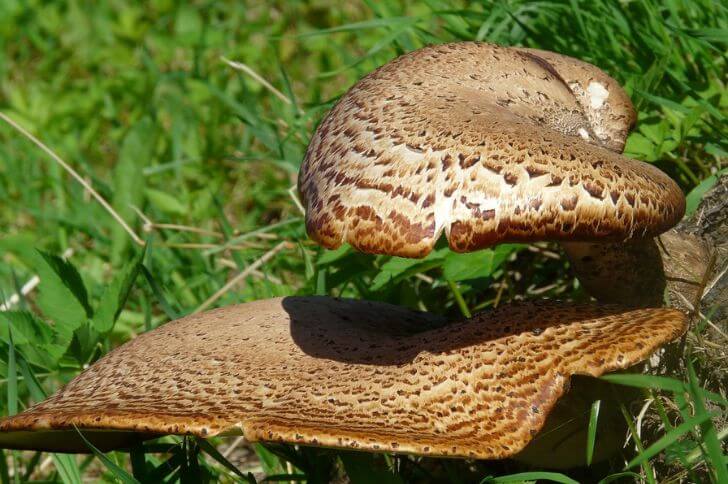
Pheasant’s back mushrooms are a unique type of mushroom that grows in tight clusters.
Identification:
They can be identified by their distinct shape and texture. This species of mushroom, also known as the Dryad’s Saddle, is identifiable by its fan-shaped structure with a scaly texture.
The underside of this mushroom has pores instead of gills which makes it easily distinguishable from other mushrooms in the same family.
The Pheasant’s Back Mushroom is typically found in damp woodlands and forests throughout North America during spring months.
It usually grows on decaying silver maple and elm trees but can sometimes be found growing on living conifers or stumps.
Its color varies from yellowish-brown to dark brown and sometimes even almost black depending on how old it is when picked. The cap size also varies between 3 to 10 inches.
15. Pink-tipped Coral Mushroom
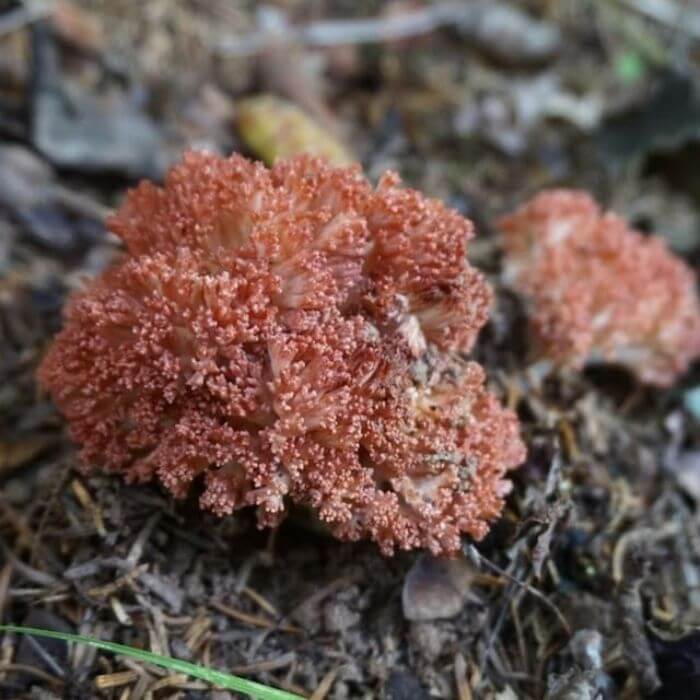
source: babygotpheasantback
Pink-tipped coral mushrooms are also known as cauliflower coral or clustered coral. Their scientific name is Ramaria botrytis.
Identification:
They are most commonly found in wooded areas. In the United States, they are common in the Southeast.
The pink-tipped coral mushroom is white with a thick stem that has a bright pink tip at the end of it.
It also produces several fungi-like structures from its surface called “fruiting bodies” which tend to be more visible during wetter months when the mushroom is actively reproducing. Its cap can range anywhere from 2.4-12 inches wide depending on its age.
Final Thoughts on mushrooms that grow on clusters
There are different types of mushrooms that grow in clusters. From the popular chanterelles to lesser known fried chicken mushrooms, the list above is perfect for new foragers as well as seasoned mushroomed hunters. If you are looking to add flavor to your meals, this list of cluster mushrooms is a perfect place to start.
Sources:
Hi There,
My name is Jenny. I’m the Chief Editor at Try Green Recipes and besides making yummy and healthy foods for my kids, grandkids, and friends. I’m new to the blogging world but I believe what I have to share is unique and will bring joy to your home. If you are adventurous and want try something tasty, let’s get started.

